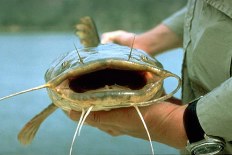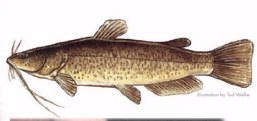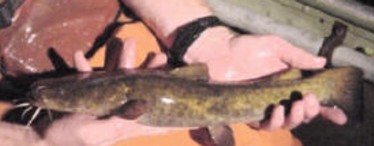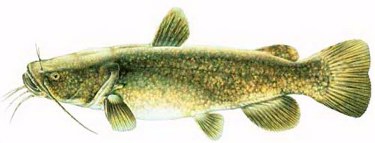 |
| Catfishing From the Dock | home |
|
   
Yellow cat, opelousas, mud cat, shovelhead cat flat head
Physical Description: · Slender or bulky body, depressed anteriorly, slightly compressed posteriorly · Broad, flat head · Small eye near the top of the head · Terminal mouth, barbels around mouth · Straight pectoral spine · Upper tip of tail pale on juveniles and some adults · Yellow or brown body and fins with brown mottling Similar species: · Widemouth blindcat (Satan eurystomus) - closest living relative Mean body size: · Adults are 400-900 mm total length
·Habitat: Flathead catfish are found in large rivers, streams and lakes, usually over hard bottoms. They prefer deep, sluggish pools, with logs and other submerged debris that can be used as cover. Young flatheads live in rocky or sandy runs in the river and in the riffles. Warm, large streams, rivers, lakes, and reservoirs · Juveniles in riffles, adults in pools · Tolerate heavy turbidity, but only slightly silted bottoms
Food Habits: During the day, flathead catfish stay out of sight, hiding beneath undercut banks, in brush piles and log jams. At night they forage in a variety of habitats, including very shallow riffles where their backs and dorsal fins may be exposed. For this reason, angling at night with live fish or crayfish as bait is the way to catch a big flathead. Biologists report that one possible feeding strategy of the flathead is to lie motionless with its mouth open, until a fish looking for a spot in which to hide swims in. Others have observed flatheads lunging and grabbing prey after they have lain in wait.
· Insects, crayfish, clams, and fish
Reproductive Habits: · Mature in 3-5 years, depending on sex · In Texas flathead catfish may spawn from late May through August.
· Nest is cleaned substrate near cover or in a cavity · Fecundity is 6,900-11,300 eggs per female Population Status, Economic, or Ecological Importance: · Good to eat, popular game fish · Very predacious, may cause decline in other fish species in other words eat everything in sight(good for cleaning out ponds)
Physical Description: · Deeply forked tail · Long, straight-margined anal fin · Stout body, round anteriorly, compressed posteriorly · Sharp dorsal and pectoral spines · Depressed head, small to moderate eye · Profile of the top of the head and nape is straight · Subterminal to inferior mouth · Gray to slate-blue colored back · Silver side Similar species: · Channel catfish (Ictalurus punctatus) · Headwater catfish (Ictalurus lupus) · Yaqui catfish (Ictalurus pricei) Mean body size: · Adults are 500-900 mm standard length Habitat: · Deep, swift water channels and flowing pools Food Habits: · Invertebrates, fish, frogs, and mollusks Reproductive Habits: · Spawning occurs in April and May in water that is 21-24oC · Nests constructed in sheltered areas by the male or both sexes ·
Flathead Fishing Tips
 |
Live bait and good habitat are the most important ingredients for catching flatheads. |
 |
Bait will stay fresh and lively longer if kept cool. |
 |
Larger bait catches larger fish. Small bait may catch large fish, but by using big bait you exclude fish that are not large enough to take the bait. |
 |
Checking and rebaiting your lines once or twice during the night will net you less sleep but more fish. Bare hooks do not catch fish, and many times a large portion of your bait will be gone by midnight. |
 |
Lots of cover combined with deep water often produces larger flatheads. |
 |
Flatheads will use brush piles in slow or little current, however the odds of catching gar and other rough fish increase in calm water. |
 |
A full moon generally means poor fishing. Large flatheads are primarily nocturnal feeders and do not move well during the near daylight conditions of a full moon. |
 |
In smaller rivers and streams, flatheads generally will not bite well if the water level is falling, but may bite more readily with rising water levels. |
 |
Flatheads often feed heavily before and after spawning but seldom feed while actively spawning. In north Missouri, they generally spawn between the last week of June and third week of July. |
 |
Tag each line with your name and address. |
 |
Experience and experimentation will teach you much more than words from even the most experienced catfish angler. |
Flatheads use both swift water and calm water, but they will almost always be near some kind of cover. Large brush piles, log jams, single trees and large rocks provide good feeding and resting locations for flatheads.
Hooks should be stainless steel. A large catfish will straighten anything else. The size should be 7/0 or 8/0. I know this sounds too large, but with the characteristically wide mouth of the flathead catfish, even a small fish can be caught on a big hook.
|
 |



